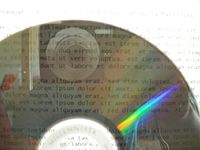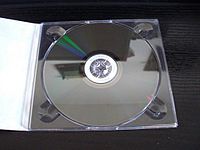M-DISC
 | |
| Media type | write-once optical disc |
|---|---|
| Standard | DVD, Blu-ray |
| Developed by | Millenniata, Inc. |
| Dimensions | Diameter: 120 mm (4.7 in) |
| Usage | Archival storage |
| Extended from | DVD+R, BD-R |
| Released | 2009 |
| Optical discs |
|---|
This article needs additional citations for verification. (October 2022) |
M-DISC (Millennial Disc) is a write-once optical disc technology introduced in 2009 by Millenniata, Inc.[1]and available as DVD and Blu-ray discs.[2]
Overview
M-DISC's design is intended to provide archival media longevity.[3][4]M-Disc claims that properly stored M-DISC DVD recordings will last 1000 years.[5]The M-DISC DVD looks like a standard disc, except it is slightly thicker[by how much?] and almost transparent. The patents protecting the M-DISC technology assert that the data layer is a glassy carbon and that the material is substantially inert to oxidation and has a melting point of 200–1,000 °C (392–1,832 °F).[6][7][8] M-Discs are readable by most regular disc drives[example needed].[9]

History
M-DISC developer Millenniata, Inc. was co-founded by Brigham Young University professors Barry Lunt, Matthew Linford, CEO Henry O'Connell and CTO Doug Hansen.[10][11][12] The company was incorporated on May 13, 2010, in American Fork, Utah.[13][citation needed]
Millenniata, Inc. officially went bankrupt in December 2016. Under the direction of CEO Paul Brockbank, Millenniata had issued convertible debt. When the obligation for conversion was not satisfied, the company defaulted on the debt payment and the debt holders took possession of all of the company's assets. The debt holders subsequently started a new company, Yours.co, to sell M-DISCs and related services.
Durability claims
According to an accelerated aging test of the French National Laboratory of Metrology and Testing in 2012, at 90 °C (194 °F) and 85% humidity, the DVD+Rs with inorganic recording layer like M-DISCs were still readable after 250 hours (equivalent of 62.5 years to 86.8 years time) with an acceptable read/error rate, and were rated "less than 250 hours" equivalent to competing offers[example needed].
The performance was better than several DVD brands[which?] using organic dyes, where discs were not always readable after 250 hours; slightly lower than another brand which achieved a lower read/error rate and was rated "250 hours"; much less than glass DVD technology, which was rated by "more than 1000 hours".[14]
Commercial support
Recorded discs are readable in most conventional drives[example needed]. Available recording capacities are similar to other optical media from 4.7 GB DVD-R to 25 GB, 50 GB BD-R and 100 GB BD-XL. With the first DVD M-DISCs[clarification needed], it was difficult to determine which was the writable side of the disc, so coloring similar to that[clarification needed] on standard DVD discs was added to later discs to help distinguish the sides.
Asus, LG Electronics, Lite-On, Pioneer, and Verbatim produce drives that can record M-DISC media. Ritek produces M-DISC Blu-ray media, sold under the Ritek and M-DISC brands. Verbatim produces co-branded discs, marketed as the "Verbatim M-DISC".[15][16]
M-Disc Alternatives
There are several, more commonly used alternatives to the M-Disc, such as hard disk drives, and solid state drives.[17]
-
M-DISC optical storage medium transparency demonstration
-
M-DISC medium in an open case
References
- ^ Wright, Randy (July 17, 2009). "Springville company introduces new DVD to protect data for a thousand years or more". Daily Herald. p. 1. Archived from the original on 2012-07-04. Retrieved October 18, 2022.
- ^ "New 1,000-Year DVD Disc Writes Data in Stone, Literally". PCMAG. Retrieved 2022-10-18.
- ^ Svrcek, Ivan (November 10, 2009). "Accelerated Life Cycle Comparison of Millenniata Archival DVD" (PDF). Life Cycle and Environmental Engineering Branch. 1 (1): 1–75.
- ^ Maltz, Andy (February 21, 2014). "WILL TODAY'S DIGITAL MOVIES EXIST IN 100 YEARS?". IEEE Spectrum. p. 1. Retrieved October 18, 2022.
- ^ "MDISC Archive Service". 2018-08-16. Archived from the original on 2018-08-16. Retrieved 2022-10-18.
- ^ US8389095B2, Allred, David E.; Bard, Erik C. & Davis, Robert C. et al., "Optical data storage media containing substantially inert low melting temperature data layer", issued 2013-03-05
- ^ US7613869B2, Lunt, Barry M. & Linford, Matthew R., "Long-term digital data storage", issued 2009-11-03
- ^ "mDisc Review: A Thousand Years of Storage - Network Computing". 2014-08-21. Archived from the original on 2014-08-21. Retrieved 2022-10-18.
- ^ "RITEK M-DISC BD DVD". www.ridata.com. Retrieved 2022-10-18.
- ^ "Barry Lunt Website". Archived from the original on 2013-10-16. Retrieved 2012-10-12.
- ^ "Matthew Linford Website". Archived from the original on 2018-08-17. Retrieved 2014-07-23.
- ^ Douglas Hansen Biography Archived 2012-05-01 at the Wayback Machine
- ^ "Springville company introduces new DVD to protect data for a thousand years or more" Daily Herald. Retrieved 17 July 2009.
- ^ Perdereau, Jacques (June 2012). "Durability of recordable DVD±R and DVD made of glass (Syylex) at elevated temperature and humidity" (PDF). Laboratoire National de Métrologie et d'Essais. 1 (1): 1–12.
- ^ "Millenniata Archiving Blu-ray M-Disc Available in Spring 2013". 2013-09-15. Archived from the original on 2013-09-15. Retrieved 2022-10-18.
- ^ "M-Disc™ Ready » The M-DISC™". 2014-03-25. Archived from the original on 2014-03-25. Retrieved 2022-10-18.
- ^ Jacobi, Jon (February 29, 2016). "Hard-core data preservation: The best media and methods for archiving your data". PCWorld. Retrieved 2022-10-24.
{{cite web}}: CS1 maint: url-status (link)



